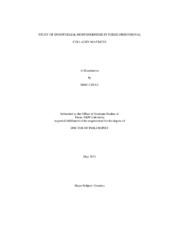| dc.description.abstract | Sprouting angiogenesis is a multi-step process consisting of basement membrane degradation, endothelial cell (EC) activation, proliferation, invasion, lumen formation, and stabilization. Such complexity reveals that the orchestration of individual genes and multiple signaling pathways are required. To better understand the mechanisms that direct the transformation of adherent ECs on the surface of collagen matrices to multicellular invading sprouts, we analyzed differential gene expression with time using an in vitro model of EC invasion driven by the combination of sphingosine-1-phosphate (S1P) and angiogenic growth factors. Gene expression changes were confirmed by real-time PCR and Western blot analyses. In addition, we have undertaken a proteomic screen to dissect downstream targets of the S1P receptors that possibly regulate EC invasion. Gene silencing or overexpression were used to examine the involvement and role of downstream targets of S1P in EC invasion into three-dimensional collagen matrices.
We demonstrated that various cell adhesion molecule genes involved in adherens junction and cell-extracellular matrix (ECM) interactions were upregulated; whereas a set of genes associated with tight junctions were downregulated. Numerous genes encoding ECM proteins and proteases were induced, indicating that biosynthesis and remodeling of ECM is indispensable for sprouting angiogenesis. Knockdown of a highly upregulated gene, A Disintegrin and Metalloproteinase with Thrombospondin-type repeats-1 (ADAMTS1), decreased invasion responses, confirming a role for ADAMTS1 in mediating EC invasion. Furthermore, differential expression of multiple members of the Wnt (wingless) and Notch pathways were observed. Functional experiments indicated that inhibition and activation of the Notch signaling pathway stimulated and inhibited EC invasion responses, respectively.
In addition, we identified annexin 2 as a regulator of endothelial morphogenesis. We observed that S1P triggered annexin 2 translocation from cytosol to plasma membrane and its association with vascular endothelial (VE)-cadherin. Moreover, annexin 2 depletion attenuated Akt activation, which was associated with increased phosphorylation of VE-cadherin and endothelial barrier leakage. Disrupting homotypic VE-cadherin interactions resulted in decreased Akt (but not Erk1/2) activation. Furthermore, expression of constitutively active Akt restored reduced EC invasion observed with annexin 2 and VE-cadherin knockdown. Collectively, we report that annexin 2 regulates endothelial morphogenesis through an adherens junction-mediated pathway upstream of Akt. | en |


